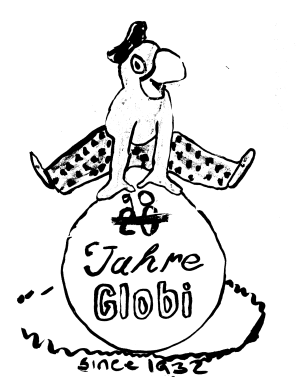Globus/Globi

In 1892, Josef Weber founded Switzerland’s first big department store “J. Weber’s Bazar” in Zurich. However, after operating for only one year the department store ran into financial difficulties and had to be sold off to the banker Heinrich Burkhardt.
Burkhardt turned things around and expanded the business to open further branches in Zurich, Aarau, Basel, Chur and St. Gallen. In 1907 he then changed the name of the department store chain to “Magazine zum Globus”.
“Magazine zum Globus” steadily continued to grow and soon became known for its advertisements. In an ad campaign for Globus in the early 1930s the marketing department under Ignatius Karl Schiele came up with the soon to be famous cartoon character “Globi”. Globi, a figure many Swiss children still grow up with today, is a blue parrot with black and red checkered pants who travels the globe. Many of the earliest Globi stories were full of racist and colonial stereotypes relating his adventures in “overseas”. In one story for example, “Globi’s Weltreise” [Globi’s trip around the world] first published in 1935, Globi travels through “Africa” and plays a “ring game” with an African “Hottentot woman” he meets. The depicted woman is supposed to represent a member of the Khoisan people and is caricatured with racist and sexist stereotypes. She appears as a “will-less object” in a land that is to Globi’s disposal as an adventurer. In the story Globi first removes the rings of jewelry the Khoisan woman is wearing around her neck and then proceeds to throw the rings from a distance, aiming at throwing them over her head, while she is passively standing there without moving.
Another figure introduced by the Globus marketing team in the 1930s was the figure of the “white n****”. The figure of the white n**** was used to advertise “Weisse Waren” [white goods, i.e. white bed linen, white table cloths, white napkins, white porcelain etc.] and was caricatured as a stereotypical black person with a white face. It was implied that he was a Black person whose face had been washed so well that it had turned white. He was mostly portrayed as a servant, often drawn with feminine traits, and was given the task of providing “Weisse Waren” that a “proper” white housewife would need to set an elegant table when entertaining guests. The “white n***” also made appearances in some of the early Globi cartoons. This figure was by no means an original, new invention by the Globus marketing department but rather played on themes and stereotypes that were common in European and North American marketing and dated back to the 19th century. Oftentimes this type of illustration was used to create a sense of social hierarchy, teaching consumers that white was equal to being civilized, and brown signified lower social and evolutionary status.

